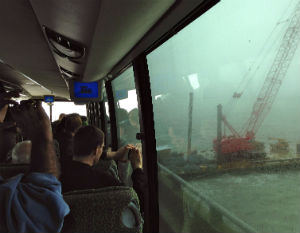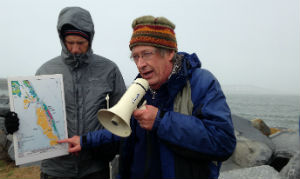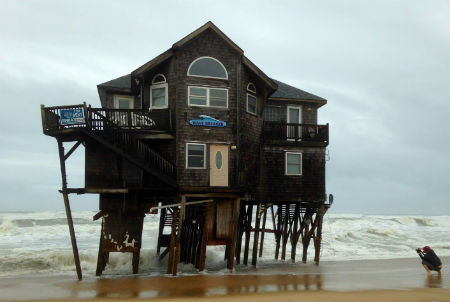Trista Talton and Catherine Kozak, two freelance reporters for Coastal Review Online, recently spent a week with other journalists on a tour of North Carolina that highlighted some of the state’s most pressing environmental issues. The tour was sponsored by the Institute of Journalism & Natural Resources in Missoula, Mont. This is the second of their two reports.
 From their seats inside a tour bus, journalists take pictures of the severe weather that frequents the Outer Banks as a part of their education on environmental issues in North Carolina. Photo: Adam Hinterhuer, IJNR. From their seats inside a tour bus, journalists take pictures of the severe weather that frequents the Outer Banks as a part of their education on environmental issues in North Carolina. Photo: Adam Hinterhuer, IJNR. |
HATTERAS ISLAND — We were approaching the Outer Banks, and a nor’easter was fulminating offshore, readying its strike. Winds were working up to 50 mph gusts, the ocean threatened to surge over the dunes at Mirlo Beach and conditions were too rough to run the ferries.
Supporter Spotlight
For a busload of antsy environmental journalists heading up the coast, the weather ultimately offered the best of all worlds: dynamic, dramatic, little risk of dying.
Eighteen of us venturing forth on the first North Carolina expedition sponsored by the nonprofit Institute for Journalism & Natural Resources were stuffed into a bus in Durham to take an eyewitness, science-soaked trek to some of the most important environmental sites in North Carolina. Naturally, one of those locations had to be the Outer Banks, ground zero for sea-level rise and the poster child for politically charged coastal projects.
Conditions never got as dangerous on the Outer Banks as anyone who has seen otherwise – say, me – knows they can get. I’ve lived and worked here for 19 years, and I’ve learned that things can go bad quickly during storms when you’re sandwiched between two huge bodies of water.
To our chagrin, the Ocracoke leg of the trip had to be nixed because the ferries were canceled. But there was a bonus, as far as the science goes at least: we were forced to take the long route down troubled N.C. 12 to Hatteras at just the right time. Running along narrow stretches of eroding barrier island, the road is often over-washed at several weak spots by the ocean, Pamlico Sound or both. Inlets had cut the road during storms
at two separate places in the last 10 years, and the road is the subject of a prolonged debate about maintaining a highway in a vulnerable coastal region.
We had traveled east on U.S. 64, with Stan Riggs, an East Carolina University coastal geologist and researcher, as science tour guide. After staying the night in Kill Devil Hills, serenaded to sleep by the steady roar of the storm-lashed ocean, we headed south on N.C. 12 to Hatteras Island,
not knowing what the weather might do to the road. By then, the northeast wind had kicked up full tilt, and the temperatures had dipped to bone-chilling.
Supporter Spotlight
Standing at the front of the bus, microphone in hand, Riggs, who has studied the Outer Banks since the 1970s, was in his element, with the busload of journalists almost like a classroom he could educate as we rolled onto the Bonner Bridge over Oregon Inlet to Pea Island, through clouds of swirling sand and ocean spray. But with the dramatic scenery, the journalists, like kids watching snow fall outside the school window, got distracted and restless, and Riggs struggled to keep their attention. One time during the trip he even chided a journalist for talking to her
seatmate instead of listening.
 Stan Riggs uses a bullhorn to be heard over the rowdy ocean. He joins the group of journalists at Mirlo Beach to share his insights on the Outer Banks. Photo: Adam Hinterhuer, IJNR. |
It might not have quite achieved nail-biting, white-knuckled tension – although our stalwart bus driver Jennifer may not agree – but we did get buffeted quite aggressively by the wind and witnessed a classic angry ocean. (She confessed later to being especially unnerved while crossing the temporary wooden bridge in Pea Island with the wind shoving the bus.)
Our consolation prize for missing Ocracoke was Mirlo Beach, all fired up with frenzied surf that roared so loud we had to shout and dressed with storm-beaten houses teetering in a tumultuous tide – a truly perfect illustration of coastal erosion and the power of surging seas.
Standing atop a dune on the edge of N.C. 12, looking north toward the wild beaches of the Pea Island National Wildlife Refuge, Riggs wielded his bullhorn to be heard over the rowdy ocean.
“When you look at that white surf out there – water has weight,” Riggs shouted over the din, holding up cardboard maps of the Outer Banks. “If you stood next to a rock wall, and you were hit by that wave, you’d be flatter than this board.”
At one point, parts of the protective dune, slammed by a several big waves in a row, started peeling away in wet lumps, falling uselessly into the roiling surf below. Coastal Review Online reporter Trista Talton, a native of Wayne County who has a family home in Kill Devil Hills, quickly scampered off the ridge onto the stable beach. From that point forward, the somewhat compromised barrier became known by Talton’s droll description, the “Dune of Death.”
Renowned for its great surfing, Mirlo Beach, a subdivision on the north end of Rodanthe, has gained even more fame – infamy, really – for its video images of dunes breached by rushing ocean swells, greenish-white froth transforming N.C. 12 into a raging river. That’s happened to some degree, in recent years, during nearly every major tropical storm or nor’easter.
“We’ve always had a barrier island and always will,” Riggs explained. “But it’s moving. So if going to put a road on it, is that a good idea? It’s not the barrier island that’s fragile; it’s the road and the houses that are put out there.”
We also got to cross the equally notorious Herbert C. Bonner Bridge, a very tired 51-year-old bridge beleaguered by lawsuits, powerful currents and shifting shoals. Replacement of the bridge over Oregon Inlet, the most perilous passage to the ocean on the East Coast, has been stayed by legal action. The bridge, which is the only link to Hatteras Island, requires frequent repairs to stay open.
The bus continued south. Ernie Foster, a Hatteras waterman, charter boat captain and N.C. Coastal Federation board member, hopped on and gave a narrated tour of historic Hatteras village, pointing out where his ancestors are buried, where fishermen work and where villagers lost their homes during major storms.
Although Foster, a former high school science teacher, acknowledged the fragile nature of his Outer Banks village, he emphasized the value of the fishing heritage and adaptability and resilience of the villagers.
 A journalist crouches near a house leaning on its last legs in the surf for a photo. This portion of the beach north of Rodanthe has been battered by storms in recent years. Photo: Adam Hinterhuer, IJNR. |
Some of the journalists in later discussions depicted Foster as trying to justify living in such a high-risk place, and I found myself having to defend the Outer Banker perspective that Foster was trying to explain: people here deserve respect for their deep roots and honorable livelihoods, even if much of it nowadays is based on tourism. Climate change may be happening before their eyes, but that doesn’t mean residents are
irresponsible by continuing to live and make a living for as long as they can in a place they cherish.
The journalists held a similarly skeptical view of Bobby Outten, the Dare County manager, because of his involvement with NC-20, the coastal development group behind the much-lambasted state resistance to scientists’ predictions on sea-level rise. They subjected him that night to the most aggressive questioning of the trip.
Outten said he represents Dare County in NC-20, which includes as members some of the 20 coastal counties and real-estate and development interests. Members run the political gamut, Outten said, and the Dare does not necessarily agree with everything in the panel’s positions.
He did, however, defend the county’s reluctance to be locked into what he considered an indefinite estimate of sea-level rise. “In terms of sea-level rise, we haven’t been debating the science one way or another,” he said in a later interview. “We can see what’s happening on our beaches. We recognize that we have to react to that.”
Outten said that it’s wrong to expect that participants in a vibrant culture and successful tourism-based economy should drop everything and move based on a 100-year projection.
“The portrayal that North Carolina, or the people on the Outer Banks, as bumpkins is misguided,” he said. “What you have are coastal people who are proud of what they have done. No one has their head in the sand.”







